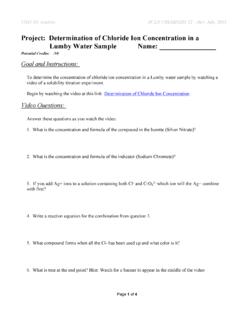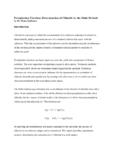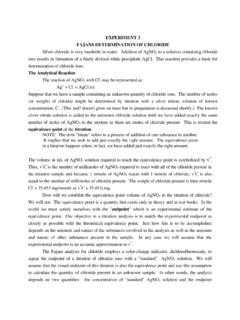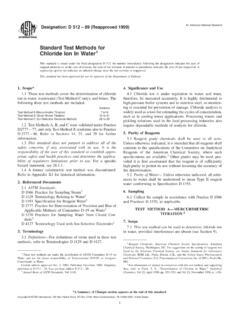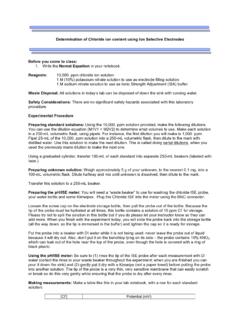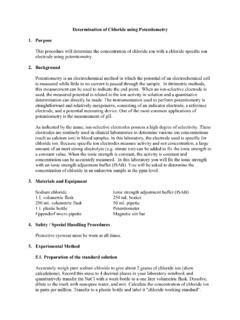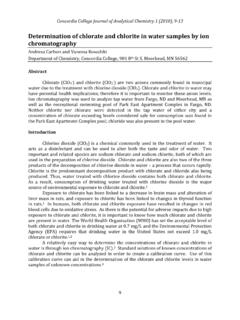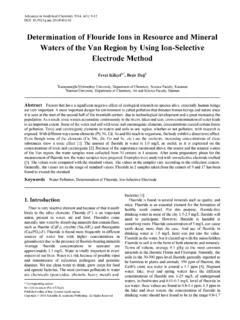Transcription of Ion-Selective Electrode Determination of Fluoride Ion
1 Chemistry 321L ManualPage 23 Ion-Selective Electrode Determination of Fluoride IonI. IntroductionA. Ion-Selective ElectrodesThe amount of a specific ion contained in an aqueous solution can be determined by directpotentiometric measurement of the voltage of a galvanic cell such as shown below. reference electrodeanalyte solutionion selective electrodeThe most common example of this is a pH measurement using a glass membrane sensitiveto H+. The Ion-Selective Electrode (ISE) typically consists of an inner reference electrodeplus a membrane that provides the interface between the sample solution and the ISE.
2 Apotential develops across the membrane that depends on the difference in the activity ofa specific ion on each side of the membrane. An internal solution with a fixed concentration(activity) of the analyte ion means that the potential developed across the membrane isrelated to the analyte activity in the sample overall measured cell potential can be expressed aswhere Eouter ref is the potential of the outer reference Electrode ;Einner ref is the potential of the inner reference Electrode ;Ejunc represents the various junction potentials that develop at liquid junction in thecell.
3 EISE is the potential developed across the Ion-Selective the measurements are made with very little current flowing in the cell, the referenceelectrode potentials are fixed, and if the sample solution is essentially the same matrix forall measurements the junction potentials are also unchanged. Then the measured cellpotential can be expressed aswhere R is the gas constant, T is the temperature (K), F is the Faraday constant, nrepresents the charge on the analyte ion and a is the activity of the analyte 321L ManualPage 24 The ISE filling solution contains a large concentration (activity) of the analyte ion and isessentially unchanged during operation of the Electrode (aion inner is fixed).
4 Thus, at 25EC,For Fluoride ion solutions at 25EC and constant ionic strength, Thus, for an ideal Fluoride ISE, the cell potential is linearly related to the logarithm of thefluoride ion concentration and should increase mV for every 10-fold decrease in the[F-]. When the ionic strength of all standards and samples is constant, the response of areal Fluoride ISE is described by a similar relationshipwhere is the electromotive efficiency and typically has a value very close to unity (> ).B. Direct Potentiometric MeasurementTo check if the Electrode is working properly, you will measure the the cell potential of threefluoride standards prepared in a total ionic strength adjustment buffer (TISAB).
5 The TISAB contains an acetic acid/acetate buffer that fixes the pH of the solution at about 5. At this pHthe formation of HF is negligible and the concentration of OH-, the only other anion that theelectrode responds to, is insignificant. It also contains NaCl to establish a high andconstant ionic strength, and a complexing agent that removes cations that could interfereby forming complexes with Fluoride . From a linear least-squares fit to a plot of Emeas versuslog[F-] you can obtain the slope [S = ( )]. Typically S equals 56 2 Method of Standard AdditionThe method of variable volume standard addition will be used to determine the fluoridecontent of an unknown solution.
6 In this approach, a solution containing Fluoride will bemixed with the TISAB and the potential will be measured. Then successive amounts of afluoride standard solution will be added and the potential will be measured after eachaddition. The following describes how the unknown Fluoride concentration can be obtainedfrom these 321L ManualPage 25 The measured potential (E) can be represented bywhere K is a constant;S is the slope of the calibration curve and equals ( );C is the analyte ion (F-) equation can be rearranged to giveThe analyte ion concentration after any addition of the standard is given by where C0 is the analyte concentration before any standard is added;V0 is the volume of the solution before any standard is added.
7 Cstd is the concentration of the standard solution;Vstd is the volume of standard solution that is this expression for C in the previous equation givesThis equation can be rearranged to giveChemistry 321L ManualPage 26A plot of 10E/S (V0 + Vstd) versus CstdVstd will give a linear plot with an x-intercept (y = 0) equalto the negative of the amount ( g) of analyte in the solution before addition of the analyte concentration ( g/mL) in the original unknown solution (Cunk) can then bedetermined by dividing by the volume of the unknown Fluoride solution (Vunk).
8 II. ProcedureA. Preparation of Fluoride Standard Solutions 1. By serial dilution of the 1000 g/mL Fluoride standard solution, prepare 50 mL each of200, 20 and 2 g/mL Fluoride standards in 50-mL volumetric flasks. After thoroughmixing, transfer each diluted standard solution to a labeled plastic reagent bottle forstorage. Calculate the concentration of each diluted standard using the exactconcentration of the stock Calibration Check of Electrode1. Carefully pipet mL of the most dilute Fluoride standard into a 50-mL volumetricflask and dilute to the mark with the TISAB.
9 Stopper the flask and thoroughly mix Transfer this solution to a 100-mL plastic beaker. Place the beaker on a stirring plate,add a magnetic stirring bar and begin stirring at a constant Connect the Fluoride ISE to a pH meter and set the meter to the mV mode. Rinse theelectrode with dionized water and blot Lower the Electrode into the standard solution. When the reading is stable record themV Repeat steps for each of the remaining Fluoride Estimate of the slope (S) from the difference in the mV readings for each factor of tenincrease in the Fluoride ion concentration.
10 If your value is outside the expected range,consult with your lab instructor. Chemistry 321L ManualPage 27C. Analysis of Unknown1. Prepare a 500 g/mL Fluoride standard by pipeting mL of the 1000 g/mL fluoridestandard solution into a 10-mL volumetric flask and diluting to the mark with the Carefully pipet mL of your Fluoride unknown, which contains the TISAB at thesame concentration as used for the standard calibrations, into a 100-mL plastic the beaker on a stirring plate, add a magnetic stirring bar and begin stirring at aconstant Rinse the ISE with deionized water and blot Lower the Electrode into the unknown solution.










